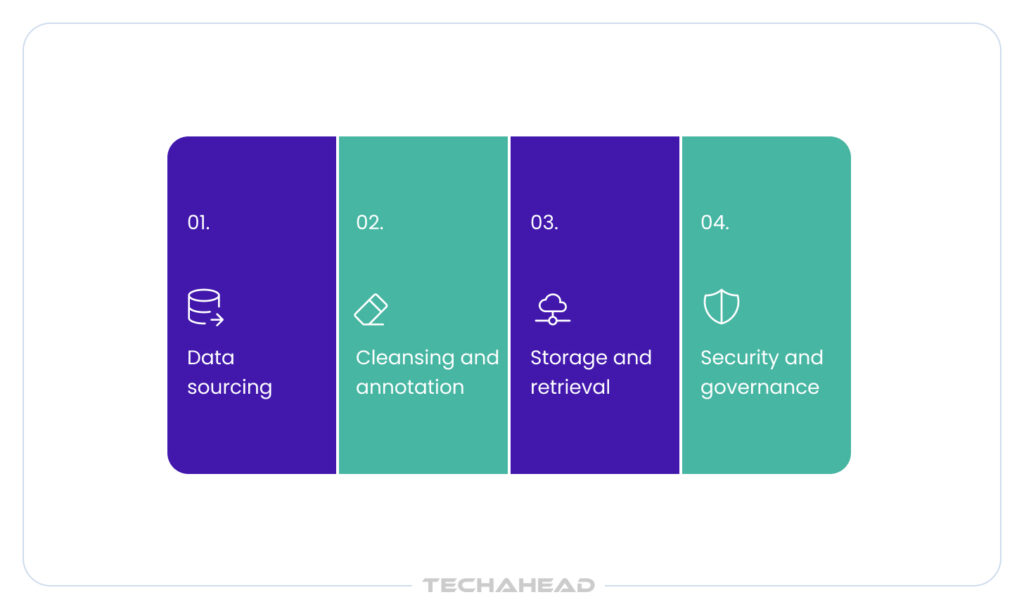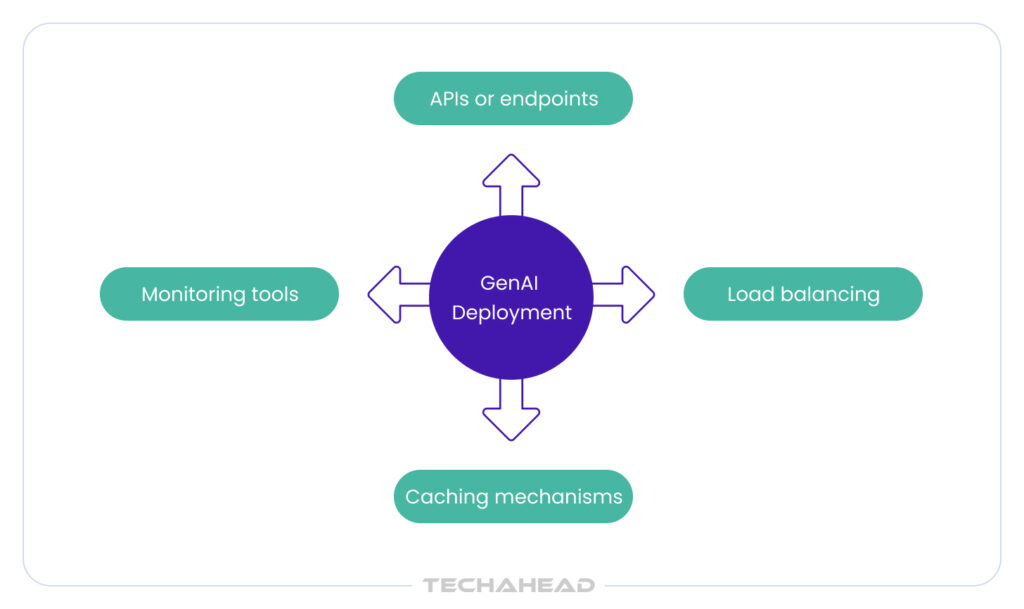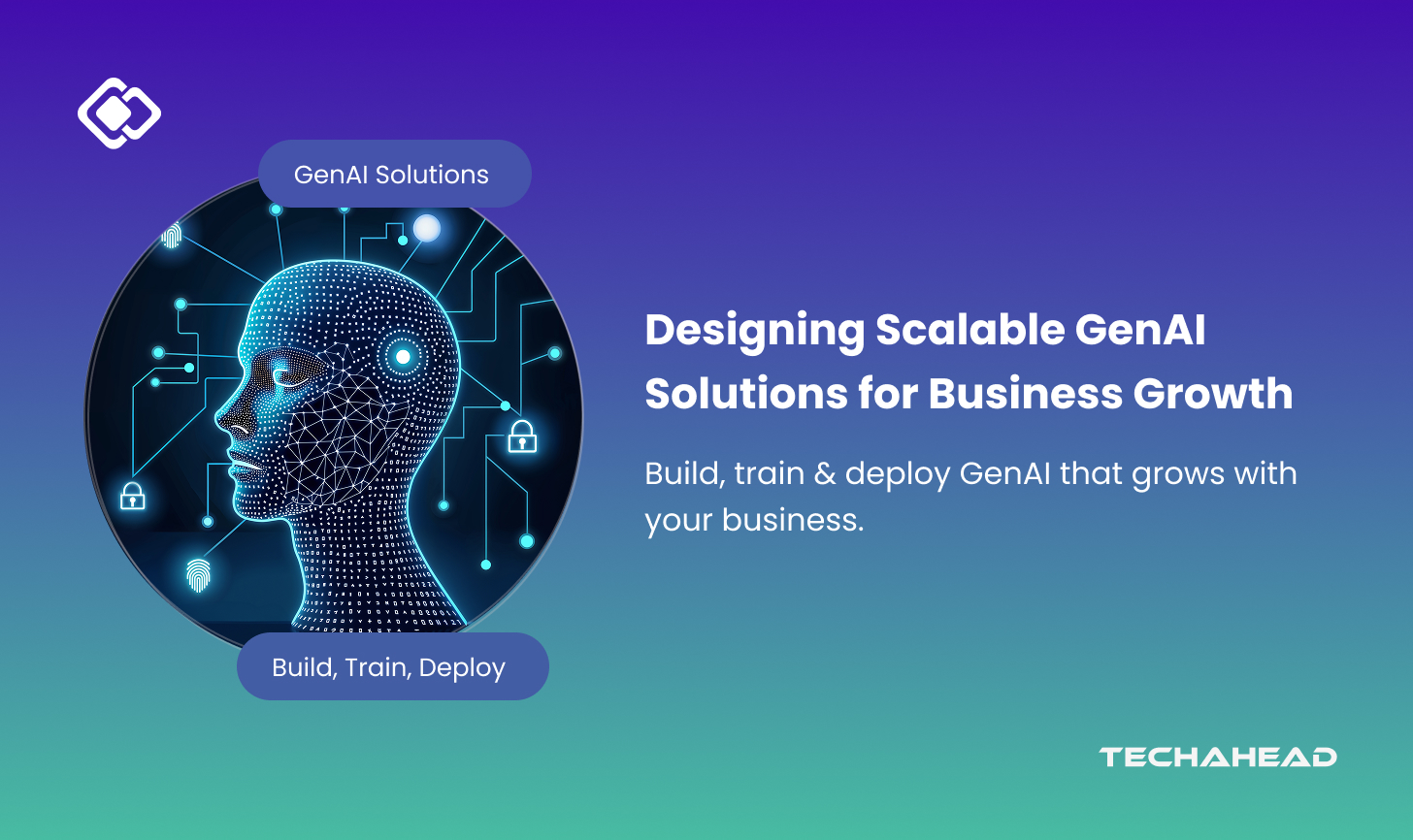“Generative AI is not just about creating something new, but about capturing what was once impossible to express. It allows machines to synthesize knowledge, ideas, and patterns at scale, which can augment human creativity. Organizations that leverage this capability responsibly can transform how they innovate and deliver value.” Timnit Gebru
Generative AI (GenAI), which began as an experimental innovation, has rapidly evolved into a business enabler. Worldwide, enterprises across industries are using GenAI for a range of activities – from accelerating content creation and enhancing customer engagement to automating operations and deriving predictive insights from data. However, moving from a small proof-of-concept to a scalable, enterprise-grade deployment presents a whole new set of challenges, including data management, model scaling, governance, and integration.
Let’s see how businesses can design and deploy scalable GenAI solutions, using the frameworks used by top generative AI companies, and discover what it takes to move from prototype to enterprise-grade implementation.
Key Takeaways
- Generative AI is reshaping how organizations create value, drive innovation, and enhance customer experiences.
- The challenge arises when scaling GenAI from proof of concept to enterprise-grade development, demanding robust data systems, governance, and continuous optimization.
- Scalability isn’t just about technology — it’s about aligning AI capabilities with real business goals.
- Scalable GenAI success comes from aligning clear objectives, robust architecture, reliable data pipelines, and ongoing optimization.
- Businesses that embrace GenAI as an evolving ecosystem, rather than a one-time deployment, will lead the next wave of digital transformation.
What Are Scalable GenAI Systems?
A scalable GenAI system isn’t just a big model that sits on a server. It’s a comprehensive ecosystem that includes:
- Data pipelines for ingestion, cleaning, and transformation
- Foundation models (like Llama, Claude, Gemini, or GPT) that generate content or insights
- Model training and fine-tuning components
- APIs or microservices to deliver real-time outputs
- Monitoring and governance layers for security, compliance, and reliability
The goal of a GenAI is to enable your AI to scale and accommodate more users, more data, and greater complexity without a drop in performance.

Example: Imagine a travel company that launches a GenAI itinerary planner. The prototype handles 100 user requests daily. But when it scales globally, it must process thousands of queries across time zones, languages, and destinations. That’s where architectural scalability, caching, and distributed computing come into play, ensuring no change in performance whether it’s a handful of users or a few thousand.
How can businesses achieve this? Let’s look at the steps one by one.

Step 1: Define Business Goals and Use Cases
The first step, before you start designing, is to ask why you’re building GenAI. Clear objectives ensure scalability aligns with business value.
Ask these key questions:
- What pain points or inefficiencies can GenAI solve?
- How will success be measured? E.g.: time saved, costs reduced, or engagement improved
- Who will use the solution—customers, employees, or both?
Example: For a retail brand’s content team, the pain point might be keeping up with frequent product launches and seasonal promotions. Writing hundreds of unique, SEO-friendly descriptions manually takes time, delaying the go-to-market. There might also be inconsistencies in tone and quality across different writers working on the content. Here, using custom generative AI to generate product descriptions and seasonal campaign ideas could reduce the content creation time by 50–70%. The success of each campaign could be measured by conversion rate, increased engagement, reduced costs, or time saved.
Leading generative AI companies in the USA start every engagement by identifying high-impact, low-risk use cases and then scaling gradually.
Step 2: Choose the Right Foundation Model
Once goals are clear, the next step is selecting or customizing your foundation model.
There’s no one-size-fits-all model. The right choice depends on your use case, data privacy needs, and computational budget.
Broadly, you have three options:
- Pre-trained models: Ideal for text generation, summarization, or chatbots.
- Fine-tuned models: Adapted to your company’s tone, terminology, or domain.
- Custom models: Built from scratch for specialized data or languages.
Example: A financial services firm may use an open-source LLM on market reports and client FAQs, fine-tuning it to generate regulatory-compliant insights. In contrast, a media company might rely on a multimodal model that handles both images and text for generating ad creatives.
Step 3: Choose Architecture for Scalability
A scalable GenAI architecture must be modular, resilient, and cloud-agnostic.
Key design principles include:
- Microservices: Break large applications into smaller components (e.g., data processing, inference, feedback).
- API-first design: Enable flexibility and easy integration with CRM or ERP systems.
- Containerization and orchestration: Docker, OpenShift, and Kubernetes are among the tools that enable scalable deployments across environments.
- Serverless workflows: Automatically handle load spikes without manual intervention.
By keeping these components loosely coupled, the business can update one layer without disrupting the entire system.
Example: A customer support GenAI system could use a microservice for message classification, a model API for generating responses, and a feedback loop to learn from customer satisfaction data.
Step 4: Build a Strong Data Strategy
Every GenAI company knows that a model is only as smart as its data.
Your data strategy for GenAI should cover:
- Data sourcing: Collect relevant, high-quality data from reliable sources.
- Cleansing and annotation: Remove noise, label correctly, and ensure diversity.
- Storage and retrieval: Use scalable databases and vector stores for fast access.
- Security and governance: Ensure compliance with data protection laws (like GDPR or HIPAA).
Example: A manufacturing company deploying a GenAI solution for predictive maintenance might train it on sensor data, maintenance logs, and failure reports. The diversity and accuracy of that data will determine how well the model predicts future equipment issues.

Image: GenAI Data Strategy
Responsible generative AI consulting companies also implement guardrails for bias detection, human oversight, and explainability, to ensure compliance with ethical AI behavior.
Step 5: Training and Fine-Tuning Models
Once your data and architecture are ready, it’s time to train or fine-tune the model.
You can:
- Fine-tune existing models with your proprietary datasets.
- Use transfer learning to speed up training and reduce compute costs.
- Leverage reinforcement learning from human feedback (RLHF) to align the model’s tone and accuracy.
Training is iterative, with continuous learning and feedback loops keeping the model relevant as your data evolves.
Example: A logistics startup could train a model to generate optimized delivery routes based on weather, distance, and traffic data.

Step 6: Deploying GenAI Models in Production
Deployment is where ideas encounter real-world conditions. A scalable GenAI deployment typically involves:
- APIs or endpoints that serve responses in real time.
- Load balancing to distribute requests evenly.
- Caching mechanisms to reduce latency for repeated queries.
- Monitoring tools to track uptime and performance.
Example: A GenAI-powered HR assistant that screens resumes and answers employee questions may start with 100 users but eventually serve 10,000 users. Using containerized deployment ensures that new servers spin up automatically when demand spikes.

Image: GenAI Deployment
Ideally, you should run a pilot with a small group of users first. Gather feedback, measure latency, and evaluate cost per inference before scaling to the entire organization.
Step 7: Monitoring, Governance, and Lifecycle Management
Once live, the GenAI model needs continuous oversight. Monitoring ensures the model remains reliable, efficient, and safe to use.
The key metrics to track continuously include:
- Performance: Response accuracy, latency, and uptime.
- Drift: Detect when input data differs from the training data, which can affect accuracy.
- Cost: Optimize compute and storage based on usage patterns.
- Compliance: Maintain transparency in data usage and output generation.
Example: If a chatbot suddenly starts producing off-brand or irrelevant responses, monitoring alerts can trigger automatic retraining or rollback to a previous model version.
Here’s where generative AI consulting companies play a vital role: managing the model lifecycle, ensuring continuous optimization, and implementing governance frameworks for ethical AI.
Step 8: Customize GenAI for Your Business
While generic models provide a solid foundation, the real value lies in building custom generative AI tailored to your domain.
Techniques like Retrieval-Augmented Generation (RAG) and vector search allow your model to reference internal knowledge bases before responding, ensuring contextual accuracy.
Example: A healthcare chatbot can retrieve verified clinical data to safely answer patient questions.
Customization helps businesses differentiate their GenAI tools, improve accuracy, and align outputs with their brand voice.
Looking Ahead — What Lies In The Future of Scalable GenAI?
The GenAI landscape is evolving rapidly, and among the trends shaping the next generation of scalable systems are:
- Autonomous AI agents that plan, reason, and act independently.
- Multimodal GenAI that blends text, images, and video for richer experiences.
- Edge AI that enables GenAI models to run on devices closer to users for faster response times.
- AI-as-a-Service platforms from leading generative AI companies that help simplify deployment and monitoring.
How to Turn The GenAI Vision into A Business Reality
Designing scalable GenAI systems isn’t a one-time project—it’s an ongoing journey of innovation and optimization. The success of GenAI depends on three pillars:
- Clear strategy anchored in business outcomes.
- Robust architecture built for growth and flexibility.
- Continuous learning guided by data, feedback, and ethical principles.
Partnering with experienced generative AI consulting companies ensures your vision doesn’t just stay an idea but evolves into a measurable, scalable solution that transforms how you work, serve customers, and grow.
Conclusion
Scalable GenAI is not just about bigger models—it’s about smarter integration, cleaner data, and responsible scaling. Whether you’re building a conversational AI, creative automation engine, or predictive insight system, start small, design for growth, and let your AI evolve as your business grows.
Businesses that embrace scalability now will be best positioned to ride the next AI wave—one that’s not just intelligent but adaptive, ethical, and human-centered. So, it’s time to future-proof your business with a scalable, intelligent, and human-centric GenAI system.
TechAhead is a leading generative AI company in the USA, with years of experience in Artificial Intelligence and related technologies. Our experts leverage top architectures and models to craft custom GenAI solutions for businesses, combining technologies to deliver high-quality, user-friendly applications that meet business objectives.

A scalable GenAI system can handle increasing workloads—more users, data, and interactions—without compromising accuracy or performance. It means that as your business grows, the AI continues to generate reliable outputs quickly, whether responding to a few or a thousand queries daily. Scalability also enables the system to adapt to new use cases and evolving data, ensuring efficiency and consistency across all operations.
Top GenAI companies design modular architectures, leverage automation, use continuous monitoring, and implement feedback loops for improvement. They approach scalability by employing modular architectures that separate components such as data processing, model inference, and user interfaces, allowing each part to grow independently. Moreover, they leverage automation for tasks such as model retraining, deployment, and load balancing, ensuring the system can handle demand spikes without manual intervention. Continuous monitoring and feedback loops help detect performance issues, optimize outputs, and improve the model over time, ensuring the AI remains reliable and efficient as usage expands.
Fine-tuning involves using an existing pre-trained model and adapting it to your specific data, such as company documents, product catalogs, or customer interactions. It allows the model to generate outputs that are more accurate and contextually relevant for your use case without starting from scratch.
In contrast, custom generative AI is built entirely from the ground up to address unique domain needs or specialized tasks, such as a medical diagnostic model trained on proprietary clinical data. While fine-tuning is faster and cost-effective, custom models offer greater flexibility and control for highly specialized applications.
Yes, smaller businesses can deploy GenAI without a massive upfront investment by starting with pre-trained models or GenAI APIs, which provide powerful capabilities out of the box. It’s best to focus on a single, high-impact use case—such as automating customer responses—before expanding to other areas. As the solution proves its value and delivers measurable ROI, it can be gradually scaled up to add more features or fine-tune the models to fit unique data and processes.




